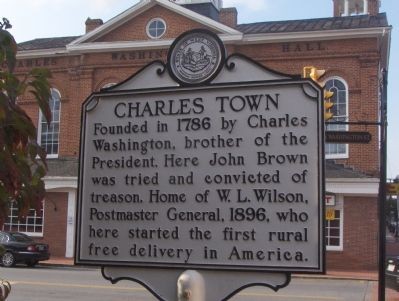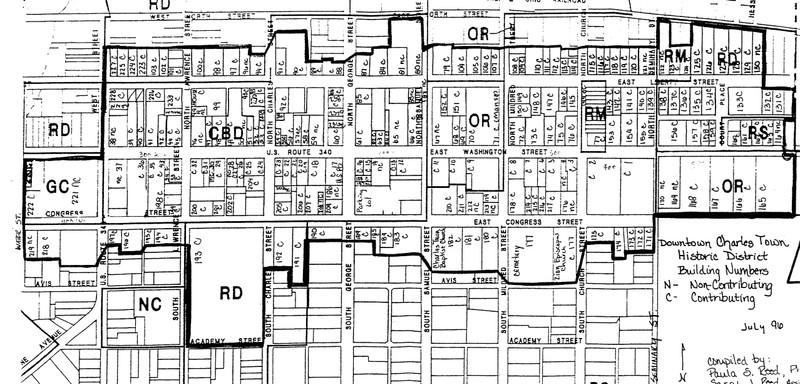This entry includes a walking tour! Take the tour.
Introduction
Text-to-speech Audio
Images
Charles Town Historical Marker

Map of the Historic District

Backstory and Context
Text-to-speech Audio
Charles Town was established in 1787 by Charles Washington, younger brother to George Washington. George and Lawrence Washington both owned large amounts of land in (then) Berkeley County, and when Lawrence died in 1752 younger brothers Charles and Samuel inherited land in the area. Charles’ property was called “Happy Retreat” and he had eighty acres divided into ½ acre plots to lay out the town in 1786. Charles named the streets after his family—Lawrence, Charles, Samuel, George, Mildred, and Washington—and for the new United States—Liberty and Congress. In his plan Charles designated the corner lots at George and Washington Streets as a public square—the Court House, City Hall, Market House, and Jefferson County Jail (now post office location) were constructed in these lots. Jefferson County separated from Berkeley County in 1801 (named for President Thomas Jefferson) and Charles Town was chosen as the county seat due to its location and the public square laid out by Washington.
Charles Town was the site of the 1859 trial and execution of John Brown after his raid on Harper’s Ferry. Brown and two of his men were tried at Charles Town because it was the county seat and Brown was hanged on December 2, 1859 at a site on the east side of S. Samuel Street. During the Civil War, Charles Town was constantly in the path of the armies due to its location at the top of the Shenandoah Valley near both Harpers Ferry and the B & O Railroad. The town was occupied for much of the war and eighteen engagements occurred at Charles Town, including two major engagements in May 1862 and October 1863.
Charles Town was the site of the first experimental Rural Free Delivery of Mail in 1896. While mail delivery was standard in urban areas, there was no mail delivery for the 65% of Americans who lived in rural areas. After a couple years of hashing out the proposal and budget in the U.S. Postal Service and Congress, Postmaster General William L. Wilson was able to start the first experimental service in Charles Town and the service quickly expanded nationwide.
Charles Town was also the site of the 1922 treason trials of union leaders and miners from the 1919-1922 Mine Wars in Logan County.
The Downtown Charles Town Historic District was placed on the National Register of Historic Places in 1997. At the time, the historical integrity of the district was high, with only 13% of the structures labeled as non-contributing. The District extends down Washington, Liberty, and Congress streets and dominant architectural styles include Federal, Greek Revival, Italianate, and Classical Revival.
Cite This Entry
Thompson, Kathleen. "Downtown Charles Town Historic District." Clio: Your Guide to History. January 7, 2021. Accessed April 6, 2025. https://theclio.com/entry/123670
Sources
“National Register of Historic Places Registration Form: Downtown Charles Town Historic District.” Accessed December 10, 2020. http://www.wvculture.org/shpo/nr/pdf/jefferson/97000263.pdf.
"Charles Town." The Historical Marker Database. Accessed December 21, 2020. https://www.hmdb.org/m.asp?m=1650.
“National Register of Historic Places Registration Form: Downtown Charles Town Historic District.” Accessed December 10, 2020. http://www.wvculture.org/shpo/nr/pdf/jefferson/97000263.pdf.

